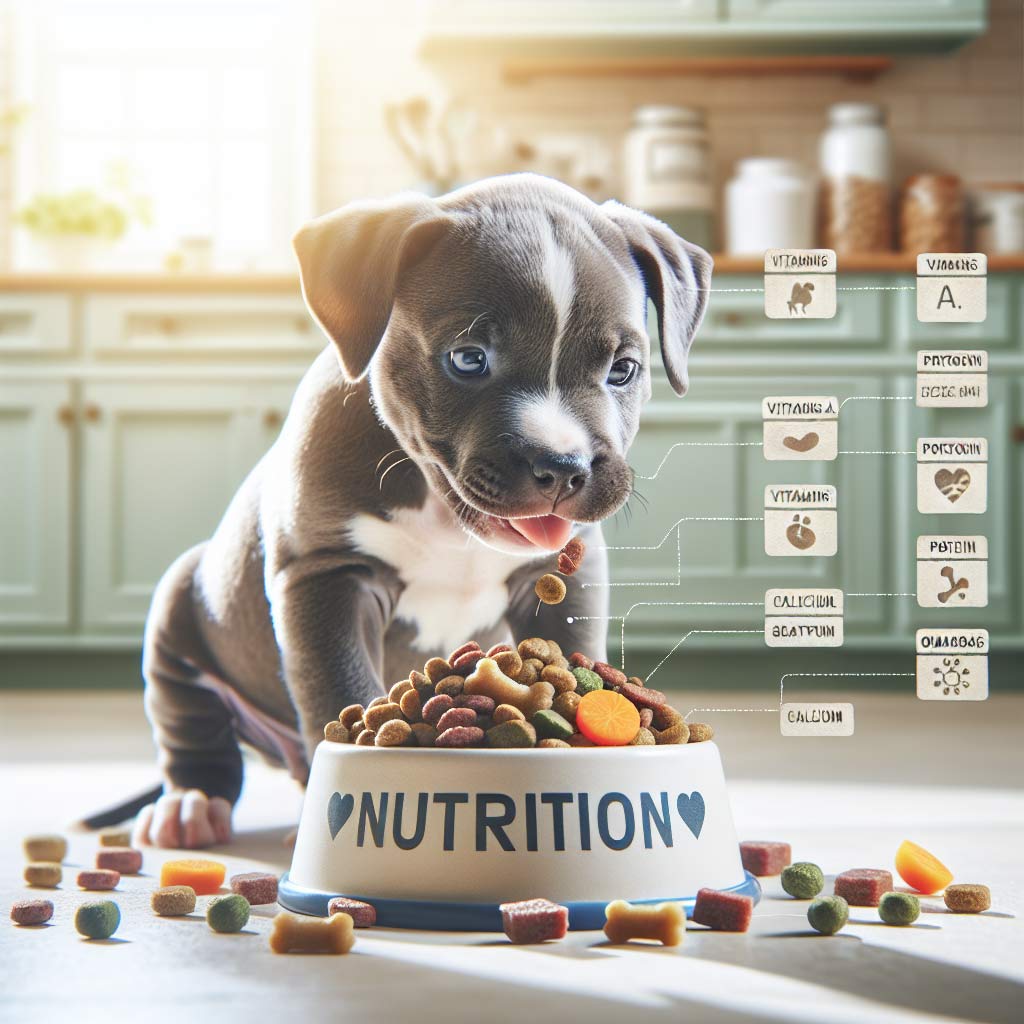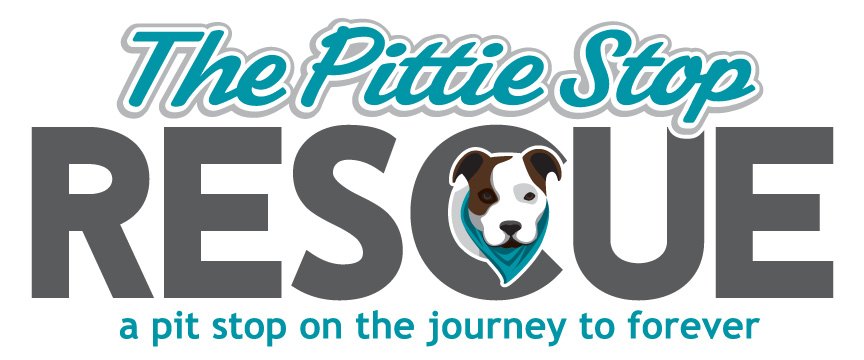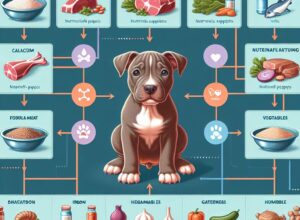
Article-at-a-Glance: Fueling Your Growing Pitbull Pup
- Discover the essential nutrients for a 4-month-old Pitbull puppy’s growth.
- Learn how to establish a feeding schedule that supports your pup’s development.
- Find out how to choose the best quality food for your Pitbull’s health and vitality.
- Decode the ingredients list on puppy food labels to make informed choices.
- Get tips on portion control to keep your Pitbull puppy fit and thriving.
Puppy Nutrition: Building the Foundation for a Healthy Pit Bull
When it comes to raising a Pitbull puppy, nutrition is the cornerstone of their health and happiness. At four months old, your Pitbull is in a crucial stage of development, and the diet you provide now can set the stage for their future well-being. It’s not just about filling their bowl; it’s about crafting a meal plan that fuels their growth and supports their energetic lifestyle. So, let’s get your pup on the path to a robust and healthy life!
Core Nutrients for Your Pitbull’s Well-Being
Like a budding athlete, your Pitbull puppy needs the right balance of nutrients to grow strong and healthy. Protein is the powerhouse that supports muscle development, and quality sources like chicken, beef, or fish should be at the top of your list. Fats are essential for energy and brain development, while carbohydrates provide the fuel for your puppy’s play. Don’t forget about vitamins and minerals; these are the building blocks for a strong immune system and overall health.
Here’s a quick rundown of what to aim for:
- Protein: Look for named meat sources as the first ingredient.
- Fats: Healthy fats like chicken fat or fish oil for a shiny coat.
- Carbohydrates: Easily digestible options like rice or sweet potatoes.
- Vitamins and Minerals: A balanced blend for all-around health.
- Calcium and Phosphorus: For strong bones and teeth.
- DHA: An omega-3 fatty acid crucial for brain development.
Navigating Feeding Times and Portions
Consistency is key when feeding your Pitbull puppy. Aim for three meals a day at regular intervals to keep their metabolism steady and their energy levels balanced. Portion sizes will vary based on your pup’s size, but a good rule of thumb is to follow the guidelines on the puppy food packaging, adjusting as necessary based on your vet’s advice and your puppy’s activity level.
Remember, your Pitbull’s stomach is small, so overloading it can cause discomfort or even lead to unhealthy weight gain. Keep a close eye on their body condition and adjust portions accordingly. A well-fed Pitbull puppy should be energetic and slim, with just a hint of their ribs visible.
What’s On the Menu? Selecting Quality Foods for Peak Development
Walking down the pet food aisle can be overwhelming with all the choices available. But not all puppy foods are created equal. Your goal is to find a food that meets the AAFCO nutrient profiles for growth and development. This ensures that the food has been formulated to meet the nutritional levels established by the AAFCO Dog Food Nutrient Profiles for all life stages.
When selecting food for your Pitbull puppy, prioritize products that are specifically formulated for large breed puppies. These foods are designed to support the rapid growth and the specific nutritional needs of larger breeds, helping to prevent joint problems and other health issues later in life.
Understanding Label Lingo: Decoding Puppy Food Ingredients
The list of ingredients on a bag of puppy food can tell you a lot about its quality. Ingredients are listed by weight, so you want to see high-quality protein sources like whole meats or meat meals at the top. By-products and fillers should be minimal or non-existent, as these offer less nutritional value.
Here’s a quick guide to what you want to see:
- Whole meats: Such as chicken, beef, or lamb, for high-quality protein.
- Meat meals: A concentrated form of protein without the moisture.
- Whole grains: Brown rice or barley for energy and digestion.
- Fruits and vegetables: For natural sources of vitamins and antioxidants.
- Named fat sources: Like chicken fat or salmon oil for essential fatty acids.
By understanding these basics, you’re well on your way to providing your Pitbull puppy with the optimal diet for their growth and health. Stay tuned as we dive deeper into the specifics of puppy nutrition and how you can ensure your Pitbull thrives during this pivotal stage of their life.
Commercial Dog Food vs. Home-Cooked Meals: Weighing the Options
When it comes to feeding your Pitbull puppy, you might be wondering whether commercial dog food or home-cooked meals are the way to go. Commercial dog foods are convenient and scientifically formulated to provide all the nutrients your growing pup needs. On the flip side, home-cooked meals allow you to control exactly what goes into your puppy’s diet and can be tailored to any specific needs or allergies.
However, cooking at home requires a solid understanding of canine nutrition to ensure your pup gets the right balance of nutrients. If you’re considering home-cooked meals, it’s best to consult with a veterinary nutritionist to create a balanced diet plan.
Grain-free or with Grains: Tailoring the Diet to Your Pup’s Needs
The grain-free diet trend has made its way into the pet food market, but is it right for your Pitbull puppy? While some dogs do better on grain-free diets, particularly those with allergies or sensitivities, grains can be a healthy part of a dog’s diet. Whole grains provide energy, fiber, and essential nutrients. The key is to choose high-quality grains like brown rice or oatmeal, which are more digestible and nutritious.
Observe your puppy’s response to their current diet. If they’re thriving, there’s no need to switch. If you notice any digestive issues or skin irritations, consult your vet about whether a grain-free diet might be beneficial.
Mealtime Strategies for the Energetic Pitbull Puppy
Feeding an energetic Pitbull puppy requires a game plan. Your pup’s boundless energy means they’ll burn through calories quickly, but it’s also essential to manage their intake to avoid growth spurts that can stress their developing bodies. A consistent routine with measured portions will help keep your puppy on track for healthy growth.
Portion Control: Preventing Overfeeding
Overfeeding is a common mistake with enthusiastic Pitbull owners, but it can lead to obesity and joint problems. Use a measuring cup to serve the exact amount recommended on the puppy food label or by your vet. Watch your puppy’s body condition closely – you should be able to feel their ribs but not see them. If your pup is looking a bit round, it’s time to cut back on the portions.
Transition Techniques for Switching Foods
There may come a time when you need to switch your puppy’s diet – whether due to a change in nutritional needs or simply moving on to adult food. To avoid upsetting your pup’s stomach, transition slowly over a week. Start by mixing a small amount of the new food with the old, gradually increasing the new food and decreasing the old until the switch is complete.
Slow Feeding: Why It Matters for Your Bully Breed
Slow feeding isn’t just about preventing choking; it’s about encouraging healthy digestion and reducing the risk of bloat, a serious condition that can affect Pitbulls. Slow feed bowls or puzzle feeders can help pace your puppy’s eating, making mealtime both mentally stimulating and safer for their digestive system.
By implementing these strategies, you can ensure that your Pitbull puppy’s nutritional needs are met in a way that promotes a healthy lifestyle and optimal growth. Remember, every puppy is unique, so it’s important to tailor your approach to your furry friend’s individual needs.
Special Dietary Considerations for Growing Pitbulls
As your Pitbull puppy grows, they may face specific dietary challenges that require your attention. It’s not just about what they eat, but also how their diet can prevent or alleviate certain health conditions. Being proactive about these considerations can lead to a healthier and happier dog.
Addressing Hip Dysplasia Concerns Through Diet
Hip dysplasia is a common concern in larger breeds, including Pitbulls. While genetics play a significant role, nutrition can also impact the development of this condition. Ensuring your puppy maintains a healthy weight can reduce the strain on their joints. Additionally, diets with the right balance of calcium and phosphorus are crucial for proper bone development. Some puppy foods are specifically formulated to support joint health, so look for those with joint-supporting nutrients like glucosamine and chondroitin.
Food Allergies and Intolerances: What to Watch For
Food allergies or intolerances can manifest in various ways, such as skin irritations, ear infections, or gastrointestinal upset. If you notice your Pitbull scratching excessively, developing rashes, or having irregular bowel movements, it might be time to investigate their diet. Common allergens include beef, dairy, wheat, and soy. A process of elimination or a hypoallergenic diet, under the guidance of your vet, can help identify the culprit.
The Role of Supplements: Are They Necessary?
Supplements can be beneficial, but they are not a cure-all. A well-balanced diet is usually sufficient for most puppies. However, if your Pitbull has specific needs or deficiencies, supplements might be recommended. Always consult with your vet before adding any supplements to your puppy’s diet to ensure they are necessary and safe.
Creating a Balanced Diet Plan: A Step-by-Step Guide
Creating a balanced diet for your Pitbull puppy doesn’t have to be complicated. With a few simple steps, you can ensure they’re getting all the nutrients they need for optimal growth.
Recommended Feeding Schedule for 4-Month-Old Puppies
At four months, your Pitbull puppy is likely a bundle of energy, and their diet needs to match that. Here’s a simple feeding schedule to keep them satisfied and healthy:
- Early Morning: Start the day with a hearty breakfast to fuel their morning activities.
- Midday: A midday meal will help sustain their energy levels through the afternoon.
- Evening: An evening meal will provide the nutrients they need to grow overnight.
Remember to adjust the portion sizes based on your puppy’s size, growth rate, and activity level. Keep an eye on their weight and body condition, and consult with your vet for personalized advice.
Treat Time: Choosing Healthy Options for Training and Rewards
Who doesn’t love spoiling their pup with treats? But here’s the scoop: treats should be just that, a treat. They’re not a substitute for a balanced diet and should make up no more than 10% of your Pitbull puppy’s daily calorie intake. Opt for healthy options like small pieces of carrot, apple, or lean cooked meats. These can be great for training sessions without packing on unnecessary pounds.
When selecting store-bought treats, keep an eye out for those with simple, wholesome ingredients and avoid those loaded with fillers or artificial additives. Remember, every little bit adds up, so keep treats small, especially during training when you might give out many.
Monitoring Your Pitbull Puppy’s Growth and Adjusting the Diet Accordingly
As your Pitbull puppy grows, their dietary needs will change. It’s crucial to monitor their growth and adjust their diet to prevent over or underfeeding. A healthy Pitbull puppy should have a visible waist and you should be able to feel their ribs without a thick layer of fat over them.
If your puppy seems to be gaining too much weight, it might be time to cut back on their food intake. Conversely, if they’re looking a bit too lean, they might need a bit more in their bowl. Regular weigh-ins and body condition scoring can help you keep track. If you’re unsure, always consult your vet for advice.
Maintaining Optimal Health Beyond the Bowl
Good nutrition is just one piece of the puzzle when it comes to your Pitbull puppy’s health. A holistic approach to their wellbeing is key. This means considering everything from their physical activity to their mental stimulation, and even the love and attention they receive from you.
Exercise: Pairing Physical Activity with Nutritional Needs
Exercise is vital for your Pitbull puppy, not just for their physical health but also for their mental wellbeing. Regular playtime, walks, and training sessions will help burn off that puppy energy and keep them fit. The amount and type of exercise will depend on their age and health, so start slow and build up as they grow.
After a workout, your pup might need a little extra fuel. Consider a small, healthy snack post-exercise to replenish their energy stores. Always provide plenty of fresh water, especially after physical activity, to keep them hydrated.
Regular Check-Ins: The Importance of Veterinary Nutrition Consultations
Your vet is your partner in your Pitbull puppy’s health journey. Regular check-ins are essential, not just for vaccinations and health screenings but also for nutrition consultations. Your vet can help you assess your puppy’s diet, suggest adjustments, and address any concerns you might have about allergies, sensitivities, or specific health issues.
Don’t hesitate to ask for a referral to a veterinary nutritionist if you’re considering a home-cooked diet or if your puppy has special dietary needs. These experts can tailor a nutrition plan that’s just right for your growing Pitbull.
Frequently Asked Questions (FAQ)
- How much food should a 4-month-old Pitbull puppy eat daily? The amount varies by individual, but generally, a 4-month-old Pitbull should eat about 2 to 4 cups of puppy food spread over three meals a day. Always check the feeding guide on your puppy food’s label and consult your vet.
- Can too much protein harm my Pitbull puppy? While protein is essential, balance is key. Excessive protein can lead to weight gain and put unnecessary strain on your puppy’s kidneys. Stick to the recommended protein content on high-quality puppy food labels.
- What should I do if my Pitbull puppy is a picky eater? First, rule out any health issues with your vet. Then, try to make mealtime more appealing by adding a bit of warm water to their kibble or offering a mix of wet and dry food. Be patient and consistent with meal times.
- Is it safe to feed my puppy raw food? Raw diets can be controversial and are not without risks, such as potential exposure to pathogens. If you’re considering a raw diet, consult with a veterinary nutritionist to ensure it’s balanced and safe for your puppy.
- How do I know if my puppy’s diet is supporting healthy growth? A diet that supports healthy growth will result in a puppy that is energetic, has a shiny coat, clear eyes, and is growing at a steady rate. Regular vet check-ups will help confirm that your puppy’s diet is on track.
How much food should a 4-month-old pitbull puppy eat daily?
Figuring out the right amount of food for your 4-month-old Pitbull puppy is crucial for their growth. Typically, puppies at this age need about 2 to 4 cups of high-quality puppy food each day, divided into three meals. But remember, this is just a starting point. Every puppy is different, and factors like activity level, metabolism, and growth rate can influence their dietary needs. Keep an eye on your pup’s body condition and energy levels, and don’t hesitate to adjust the portions accordingly. If you’re ever in doubt, your vet is just a phone call away to provide personalized advice.
Can too much protein harm my pitbull puppy?
Protein is vital for your Pitbull puppy’s muscle development, but balance is the name of the game. While a protein-rich diet is beneficial, too much can lead to unnecessary weight gain and could put a strain on their developing kidneys. Stick to the recommended protein levels found on quality puppy food labels, and you’ll be in the clear. Remember, moderation is key to keeping your puppy healthy and happy.
What should I do if my pitbull puppy is a picky eater?
Dealing with a picky Pitbull puppy can be a test of patience. First, ensure there’s no underlying health issue by consulting your vet. Once health concerns are ruled out, try enhancing the flavor of their food by adding a little warm water or chicken broth. You can also rotate between different protein sources to keep things interesting. Consistency is crucial, so stick to regular feeding times and don’t leave food out all day. With a little persistence and creativity, you’ll find the key to your pup’s appetite.
Is it safe to feed my puppy raw food?
Raw diets for dogs have their advocates and critics. While some believe raw food promotes a shinier coat, cleaner teeth, and higher energy levels, there are also risks to consider, such as the potential for bacterial contamination and nutritional imbalances. If you’re leaning towards a raw diet, it’s essential to do your homework and consult with a veterinary nutritionist. They can help you navigate the complexities of raw feeding to ensure it’s safe and nutritionally complete for your puppy.
How do I know if my puppy’s diet is supporting healthy growth?
A well-rounded diet will result in a Pitbull puppy that’s full of life, with a glossy coat, bright eyes, and steady growth. Your puppy should be eager to play and explore, and their body should be fit, not too skinny or chubby. Regular vet visits, including weigh-ins and growth tracking, will confirm that your puppy’s nutritional needs are being met. If you notice any red flags, such as lethargy or poor coat quality, it’s time to reassess their diet.
As we wrap up, remember that feeding your 4-month-old Pitbull puppy is about more than just filling their bowl. It’s about nurturing their growth, safeguarding their health, and setting the stage for a long, joyful life together. Armed with the right knowledge and resources, you’re now equipped to provide the best nutrition for your furry friend. Keep learning, stay observant, and enjoy every precious moment with your growing pup. They’ll thank you with endless love and loyalty, and that’s the greatest reward of all.



